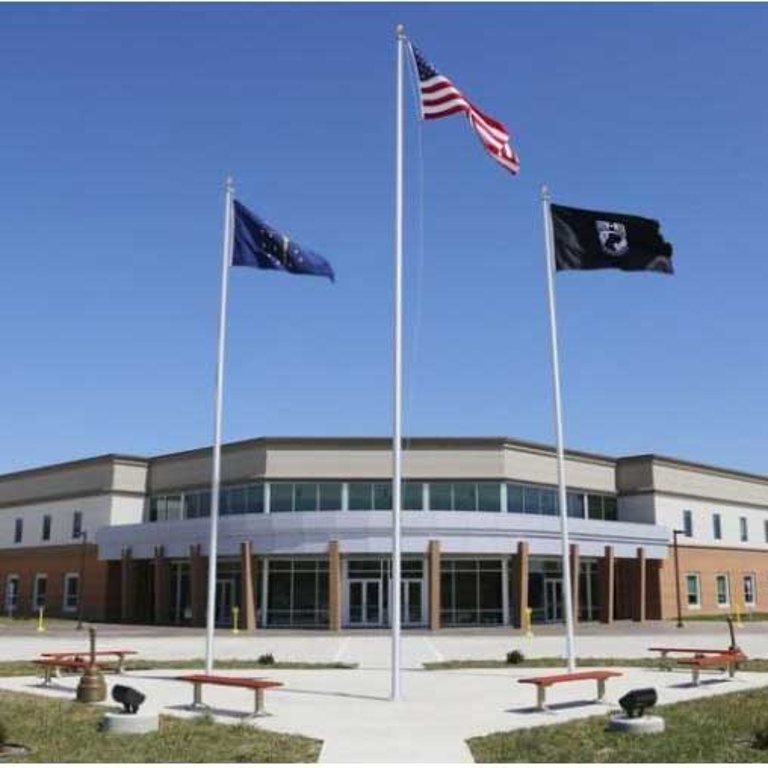They were 15 graduate students from the School of Public and Environmental Affairs, but also they were consultants to some of the most powerful leaders in the region.
In a classroom at the Kelley School of Business, a dozen representatives from groups like Cook Group, Indiana University and Crane sat at a table and listened to what the second-year master’s students thought 11 counties in “Southwest Central Indiana” could do to promote economic development. It was the culmination of a semester-long “Capstone” project, answering a question members of a steering committee, funded by the Lilly Endowment, have yet to really wrap their heads around.
In less than two hours, they peppered the committee with ideas about strengthening the technology transfer offices at IU and Crane, transforming findings in labs at the research institution and the military manufacturer into commercial products. They threw out data that supported the idea that access to health care facilities and the presence of a “creative class” leads to more opportunities for growth. They pointed to the region’s parks and natural features, which could be the foundation for increased tourism.
The presentation was just another rock being turned over, according to the committee’s chairman, Dan Peterson, the vice president for industry and government affairs at Cook. At the same time, David Audretsch, the professor for the class, had no illusions that his students would unveil a defined path for the region.
But they will certainly take credit if pieces of their report find a way into the steering committee’s final plan, he joked, comparing it to Al Gore’s “discovery” of the Internet.
“We are going to be the Al Gore to the great economic development of this region,” Audretsch said. “If he can claim the Internet, we’ll say, when the region grows, ‘We did it!’
“I don’t think they’ve provided exactly what the solution will be,” he said about his students, “but they’ve given a little food for thought.”
After the presentation, Commander James Stewart of the Naval Surface Warfare Center at Crane conferred with graduate students Thomas Leonard, David Salmonson and Evan Tyrrell about their portion of the presentation, which suggested Crane and IU create a database of their ongoing work, increasing awareness of breakthroughs being made and what could be commercialized. Stewart found a flaw — researchers at Crane, developing a top-secret laser, wouldn’t want to share their progress —but he told them it would be possible for Crane and IU to think about swapping personnel, the arms manufacturer sending an employee to collaborate with researchers at IU or vice versa.
The presentation was just another jumping-off point for the committee, which hopes to have some recommendations for ways to invest in the region by the fall of 2014. The students were valuable, in part, because many of them aren’t from Indiana, said Tina Peterson, the president and CEO of the Community Foundations of Monroe County and Bloomington.
Southwest Central Indiana has enough directional elements to its name to make it seem like its 11 counties shouldn’t be lumped together. But the Lilly Endowment decided to take $650,000 and spur the creation of a steering committee to look at boosting economic development in that area, including Owen to the north, Crawford to the south, Daviess to the west and Washington to the east.
As benchmarks, the IU group looked at such regions as North Alabama, which has a campus of the University of Alabama in Huntsville and the NASA Marshall Space Flight Center, as well as “Innovation Valley” in Tennessee, six counties that contain Oak Ridge National Laboratory and the University of Tennessee in Knoxville. When they looked at IU and Crane, they saw a “mission discrepancy” between the two institutions – one a state university and the other a weapons manufacturer. Neither has produced large amounts of spin-off products.
Indiana University Research and Technology Corporation, for example, only has one of its nine technology developers based in Bloomington, the students found. Most of them are in Indianapolis, involved with IU Health.
On top of Crane and IU, the steering committee sees potential in an area that’s rural but has equal access to great minds and unique entertainment. There are parks to boost a tourism industry, along with the might of a military manufacturer and the minds of the state’s top research institution. But it’s no small challenge to take 11 counties that don’t necessarily see themselves as linked and form a plan to invest in a whole, the community foundation’s Peterson said.
These IU students gave the committee a bit more to consider.
“It takes a great deal of information to distill it down and figure out ‘Where is the place that we plant our flag? Where can we, as a region, be most impactful?’” she said. “What can we uniquely do, so we can see ourselves as 11 counties that have the assets to create a very complete region?”


